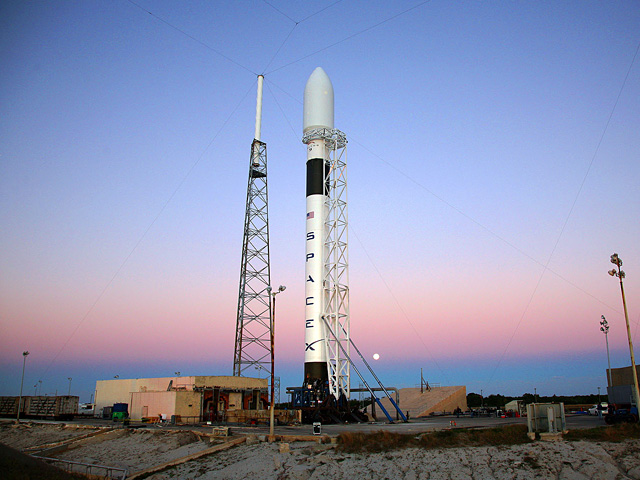SpaceX’s Falcon 9 on Launch Pad at Cape Canaveral (with photos)

Launch vehicle selected by NASA to replace the cargo transportation function of the Space Shuttle conducts launch pad system checks in preparation for test flight later this year
Hawthorne, CA – (January 12, 2009) – Space Exploration Technologies Corp (SpaceX) announced its Falcon 9 launch vehicle was successfully raised to vertical on Saturday, January 10, 2009, at Space Launch Complex 40 (SLC-40) in Cape Canaveral, Florida — two days ahead of schedule. This operation was a critical step in validating a variety of system interfaces and launch processes in preparation for the maiden flight of Falcon 9 later this year.
“Any engineered system has requirements that can only be recognized through actual assembly of real hardware,” stated Brian Mosdell, Director of Florida Launch Operations for SpaceX. “This rapid integration and stand-up provided our engineers and technicians with invaluable insights that will greatly streamline our efforts towards the first Falcon 9 launch in 2009.”
SpaceX completed the Falcon 9 vehicle integration in a horizontal position on December 30, 2008. After integration, Falcon 9 was lifted and mated to a transporter erector system, designed and built by SpaceX, which carried the 17 foot diameter, 180 foot long rocket to the launch pad. On January 10, 2009 at 12:45 PM EST, SpaceX began the process of raising Falcon 9 and approximately 30 minutes later, Falcon 9 stood vertical at the Cape.
“This entire process has helped us validate key interfaces and operations prior to executing our launch campaign with the vehicle in its final flight configuration,” said Elon Musk , CEO and CTO of SpaceX. “We encountered no show-stoppers or significant delays. I am highly confident that we will achieve our goal of being able to go from hangar to liftoff in under 60 minutes, which would be a big leap forward in capability compared with the days to weeks required of other launch vehicles.”
This latest accomplishment follows closely on a series of recent successes for SpaceX. In November 2008, SpaceX successfully conducted a full mission duration firing of Falcon 9, validating SpaceX’s use of nine engines on the first stage, as well as the ability to shut down engines without affecting the remaining engines. In December 2008, NASA selected the Falcon 9 launch vehicle and Dragon spacecraft as the primary means of transporting cargo to and from the International Space Station after the Space Shuttle retires in 2010.
Photos and video of the Falcon 9 vertical operations can be found on our website at www.SpaceX.com .
About SpaceX
SpaceX is revolutionizing access to space by developing a family of launch vehicles and spacecraft intended to increase the reliability and reduce the cost of both manned and unmanned space transportation, ultimately by a factor of ten. With its Falcon line of launch vehicles, powered by internally-developed Merlin engines, SpaceX offers light, medium and heavy lift capabilities to deliver spacecraft into any altitude and inclination, from low-Earth to geosynchronous orbit to planetary missions. On September 28, 2008, Falcon 1, designed and manufactured from the ground up by SpaceX, became the first privately developed liquid fuel rocket to orbit the Earth, demonstrating that low cost and reliability can be coupled in commercial spaceflight.
As a winner of the NASA Commercial Orbital Transportation Services competition (COTS), SpaceX is in a position to help fill the gap in American spaceflight to the International Space Station (ISS) when the Space Shuttle retires in 2010. Under the existing Agreement, SpaceX will conduct three flights of its Falcon 9 launch vehicle and Dragon spacecraft for NASA, culminating in Dragon berthing with the ISS. SpaceX is the only COTS contender with the capability to return cargo and crew to Earth. NASA also has an option to demonstrate crew services to the ISS using the Falcon 9 / Dragon system. NASA recently selected the SpaceX Falcon 9 launch vehicle and Dragon spacecraft for the International Space Station Cargo Resupply Services (CRS) contract award. The contract includes 12 flights between 2010 and 2015, which represents a guaranteed minimum of 20,000 kg to be carried to the International Space Station.
Founded in 2002, the SpaceX team now numbers more than 620 full time employees, located primarily in Hawthorne, California, with additional locations, including SpaceX’s Texas Test Facility in McGregor near Waco; offices in Washington DC; and launch facilities at Cape Canaveral, Florida, and the Marshall Islands in the Central Pacific.

Photo Caption: View from high above the SpaceX Falcon 9 rocket as it stands vertical on its pad at Cape Canaveral, Florida. The SpaceX team completed vehicle integration on December 30, 2008, and the new SpaceX-built transporter and erector system raised the 17 foot diameter, 180 foot long rocket to vertical via massive hydraulic cylinders.

Photo Caption: Sunset behind the SpaceX Falcon 9 rocket as it stands vertical on its pad at Cape Canaveral, Florida.

Photo Caption: Moonrise behind the SpaceX Falcon 9 rocket as it stands vertical on its pad at Cape Canaveral, Florida.

Photo Caption: The full moon sets behind the SpaceX Falcon 9 rocket as it stands vertical on its pad at Cape Canaveral, Florida.

Photo Caption: Arc lights illuminate the SpaceX Falcon 9 rocket as it stands vertical on its pad at Cape Canaveral, Florida.

Photo Caption: Moonrise behind the SpaceX Falcon 9 rocket as it stands vertical on its pad at Cape Canaveral, Florida.








